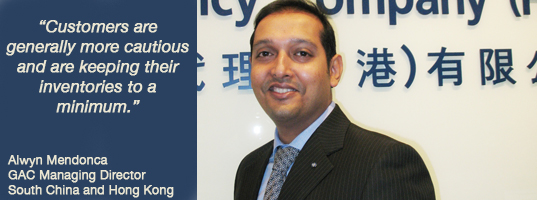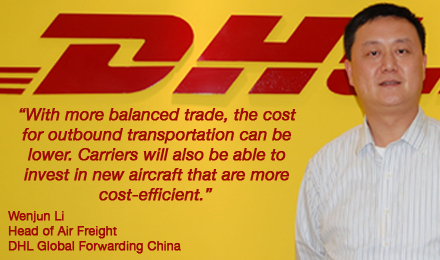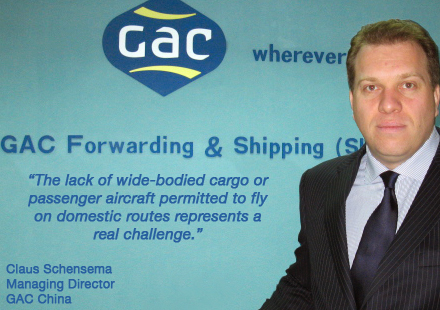|

Throughout 2011 and now into 2012, Air
Cargo News FlyingTypers has led the way in tracking the latest changes
impacting air cargo lanes in China. As last year progressed and finally
concluded, some trends became more pronounced, particularly the rising
demand for imports, which enabled carriers to partially offset the bearish
export market.
 But pinning a uniform tag on export lanes has
been difficult. While southern China, the traditional manufacturing
powerbase, has generally struggled this year, volumes out of central,
northern, and western China have been surprisingly perky. With 2011
drawing to a close, we asked leading air freight forwarding executives
to explain what were the causes behind the structural changes in air
freight flows to and from China, and whether we’ll see these trends
accelerate or slow as 2012 moves along.
But pinning a uniform tag on export lanes has
been difficult. While southern China, the traditional manufacturing
powerbase, has generally struggled this year, volumes out of central,
northern, and western China have been surprisingly perky. With 2011
drawing to a close, we asked leading air freight forwarding executives
to explain what were the causes behind the structural changes in air
freight flows to and from China, and whether we’ll see these trends
accelerate or slow as 2012 moves along.
We spoke with Alwyn Mendonca, GAC Managing
Director, South China and Hong Kong; Wenjun Li, Head of Air Freight
at DHL Global Forwarding China; Robert Timmerman, Panalpina Area Manager,
Greater China; and Claus Schensema, Managing Director, GAC China, about
how air cargo service demands to and from China fared in 2011 and how
well they would fare in 2012.
 Both
Mr. Li and Mr. Mendonca were optimistic regarding demand in 2012. Mr.
Mendonca saw volumes increase from Central and Northern China; however,
“It is a very different story for Southern China and Hong Kong,
where there has been a drastic drop in volumes this year,” he
said. He forecasted that drop to continue in 2012, adding, “Customers
are generally more cautious and are keeping their inventories to a minimum.” Both
Mr. Li and Mr. Mendonca were optimistic regarding demand in 2012. Mr.
Mendonca saw volumes increase from Central and Northern China; however,
“It is a very different story for Southern China and Hong Kong,
where there has been a drastic drop in volumes this year,” he
said. He forecasted that drop to continue in 2012, adding, “Customers
are generally more cautious and are keeping their inventories to a minimum.”
Mr. Timmerman expressed that China “has
seen a much higher growth rate on its imports,” and believes that
the trend will continue “given the strong domestic demand and
the 5-year plan of the Chinese government.”
“Over time, there will be a balance
in trade on the outbound versus inbound volumes and, ultimately, even
an imbalance with higher imports than exports,” said Mr. Timmerman.
For now, it seems imports are a stronghold
in China. “Import is our primary source of revenue growth. For
the foreseeable future, we are continuing to focus on imports for niche
markets such as the automotive, oil & gas and tooling industries,”
said Claus Schensema.
More balanced trade is beneficial to both
companies and customers in a number of ways, not the least of which
is in freight rates.
“Greater balance of payment between
countries gives GAC better cash flow. Our customers who rework products
before exporting them to third party countries also stand to benefit,”
said Mr. Schensema.
Mr. Timmerman sees balanced trade as one
hand washing the other, with balanced trade helping carriers “as
a higher yield opportunity will exist on both inbound and outbound.
“To date, carriers have to a large
extent depended on the outbound yield. Increasing revenue streams on
the inbound may make the carriers apply more lenient export rates.
 “However,
the presently applied rate levels are far below the cost of the carriers.
Hence, upward adjustments will be needed to ensure the carriers’
survival,” said Mr. Timmerman. “However,
the presently applied rate levels are far below the cost of the carriers.
Hence, upward adjustments will be needed to ensure the carriers’
survival,” said Mr. Timmerman.
Wenjun Li sees capacity imbalance as a
primary cause for freight rate hikes in outbound cargo. “With
more balanced trade, the cost for outbound transportation can be lower.
“Carriers will also be able to invest in new aircraft that are
more cost-efficient such as the B747F-400 and the B747-8, which can
help save on unit costs with optimized loading and round-trip volumes,”
said Mr. Li.
With increasing demand from areas other
than the coast, many are working hard to ensure capacity is being met
for these inland areas.
“We’ve seen demand from west
and inland cities increasing. We are working closely with both carriers
and customers to handle the increasing capacity. The surge is primarily
in outbound and not inbound,” said Mr. Li.
“GAC has achieved phenomenal growth
over the past two years, especially in Chengdu.
“We shall continue to focus on Central
China, especially Chengdu and Chongqing,” said Claus Schensema,
Managing Director, GAC China.
The real challenge faced by those moving
more and more goods in and out of China is adequate capacity in terms
of both cargo aircraft, designated cargo facilities, and flight permits.
“The lack of wide-bodied cargo or
passenger aircraft permitted to fly on domestic routes represents a
real challenge,” said Mr. Schensema.
“This issue was again raised at
the recent Shanghai Freight Forwarders’ Association forum, and
the Civil Aviation of the People’s Republic of China has made
a commitment to look into the matter.
“Once wide-bodied aircraft are permitted
to fly these routes, pricing and cargo facilities will become more competitive,”
concluded Mr. Schensema.
“Airports like Chengdu, Chongqing,
Wuhan and Zhengzhou will see an increased main deck capacity to support
the export demand,” said Robert Timmerman, Panalpina Area Manager,
Greater China.
“To some extent, the yield a carrier
can gain in operating from these airports is higher than operating from
the main gateways on China’s coast.
“Carriers are looking for new revenue
streams because the slow global economy has led to a shortfall in volumes
and the present rate erosion.
 “Panalpina has set up offices in
the aforementioned cities. We are thus in a very good position to support
the business development of our customers,” said Mr. Timmerman.
“Panalpina has set up offices in
the aforementioned cities. We are thus in a very good position to support
the business development of our customers,” said Mr. Timmerman.
Mr. Li is optimistic that capacity needs
are being met: “Plenty of aircraft capacity has been injected
into China markets. Local carriers have increased capacity for the west
and inland lines, as government policy has encouraged local carriers
to develop transportation for the western and inland cities.”
Fortunately, the increasing volume of
shipments is not being negatively affected by equally increasing rates.
“With the Chinese government’s
Go West Policy, the rates for the west and inland China lines will be
reduced with more carriers coming into the market.
“With favorable local customs policies,
more direct shipping to final destination is also encouraged,”
said Mr. Li.
The final step in making China run like
clockwork will be in refining freight hubs so that they meet the standards
required by modern supply chains.
“At present only air freight hubs
such as Shanghai, Beijing, Tianjin and Guangzhou (PVG/BJS/TSN/CAN) can
meet the requirements of short lead times, with airports in inland and
west China still in need of further development to meet time critical
requirements,” said Mr. Li.
All in all, the future for China is looking
good, and 2012 being the year of the Dragon, one can only imagine it
will get better and better
Sky King/Flossie
|



